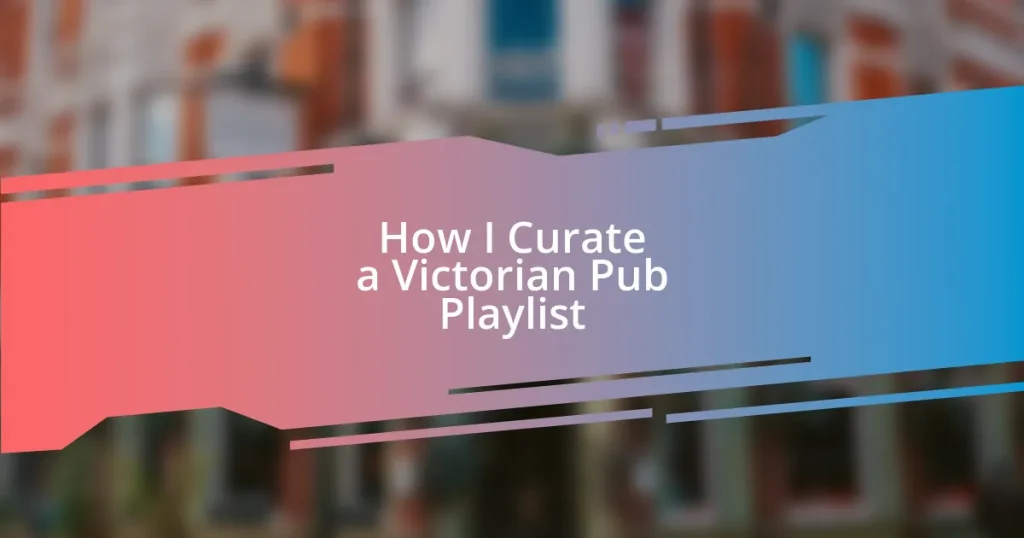Key takeaways:
- Victorian pubs served as important social hubs where music and conversation fostered community connections among workers.
- Key music genres of the Victorian era included Music Hall, British Folk, and Classical influences, enriching the pub atmosphere.
- Creating an engaging playlist involves curating a mix of lively and reflective songs, considering transitions and the overall emotional tone.
- Regularly updating the playlist with new renditions and audience feedback is essential to maintain a vibrant and enjoyable experience.

Understanding the Victorian Pub Culture
Victorian pub culture was a fascinating mix of social interaction, music, and community spirit. Picture this: after a long day, workers would gather at their local pub, not just to drink, but to share stories, laughs, and even grievances. Doesn’t it make you wonder what those conversations might have sounded like, echoing off the timber-paneled walls?
These establishments served as vital social hubs, particularly for the working class. I can almost feel the camaraderie in the air during one of those lively evenings. It was a place where everyone, no matter their background, could find solace in a pint and a friendly chat. Have you ever walked into a bar and felt an instant connection? That was the essence of a Victorian pub.
Music played a crucial role in the ambiance, shaping the patrons’ experiences. From raucous sing-alongs to gentle ballads, the melodies provided a soundtrack to their lives. I find myself reflecting on how music has this incredible power to bring people together. Isn’t it intriguing to think that these communal spaces helped forge identities and friendships that have echoing effects even today?

Researching Victorian Music Genres
When diving into the melodies that filled Victorian pubs, I found it essential to explore various music genres that were popular during that era. It’s intriguing to think about how the diverse sounds reflected the societal shifts of the time. I often imagine pub-goers enjoying lively tunes that transcended borders, like lively jigs that fueled their spirits after a long day.
To get a better grasp of Victorian music genres, I focused on these key areas:
- Music Hall: This genre featured comedic songs and sketches, often centered around everyday life, making it relatable and entertaining.
- British Folk: Traditional folk music, passed down through generations, connected people to their roots and community stories.
- Sheet Music Popularity: The rise of printed music allowed individuals to play and sing popular tunes at home or in pubs, fostering shared musical experiences.
- Classical Influence: The Victorian era also saw a blend of classical styles, where orchestral pieces could often be heard transitioning through pubs, creating a sophisticated ambiance.
I remember finding old sheet music in a dusty bookshop that transported me to another time, evoking a sense of nostalgia. It’s remarkable to think about the lived experiences and emotions tied to each tune, all playing out in those cherished spaces.

Selecting Key Music Artists
Selecting key music artists for a Victorian pub playlist is an essential step for capturing the spirit of that vibrant era. I’ve found that focusing on artists who embody the musical genres of the time can transform the atmosphere of any gathering. For instance, including musicians who specialized in Music Hall tunes can lighten the mood and spark laughter, making it reminiscent of the jovial interactions that would have filled those old pubs.
Exploring artists who have revived traditional British folk songs also enriches the playlist. I remember the first time I heard a modern rendition of a Victorian folk tune; it painted a vivid picture of communal gatherings, where friends shared stories. It’s interesting to see how these songs can bridge the past and present, connecting us to the celebrated histories of our communities.
Interestingly, I often create my playlist by weaving together a mix of well-known and more obscure artists. Including lesser-known figures not only showcases a diverse sound but invites listeners into a deeper exploration of the era. Don’t you think it’s the unique and often hidden gems that truly enhance our understanding of historical music? The richness in diversity is what makes the playlist so compelling.
| Genre | Key Artist |
|---|---|
| Music Hall | George Leybourne |
| British Folk | Kate Rusby |
| Sheet Music Influences | The Safety Pin Band |
| Classical Fusion | Shostakovich Quartet |

Creating an Atmospheric Playlist
Creating an atmospheric playlist requires more than just picking songs; it’s about curating an experience. I often start by envisioning the feel of a Victorian pub. Imagine the chatter and laughter mingling with the melodies—what songs would enhance that ambiance? Including lively jigs next to melancholic ballads sets the emotional tone and invites patrons to immerse themselves in a nostalgic dance.
I also consider the transitions within the playlist. For example, after a foot-stomping Music Hall piece, it feels natural to flow into a soothing folk song that encourages storytelling. This ebb and flow keeps the atmosphere dynamic. I remember once at a gathering where I carefully curated a list but ended up switching the order last minute. The change in dynamics sparked conversation and laughter, revealing how crucial that ordering can be for engagement.
Finally, I ensure each song tells a story. When I hear a particular tune, I often think about the people who would have listened to it, the emotions reflected in their faces. Did it bring them joy or nostalgia? I challenge you to think about the songs that mean something to you—how do they evoke the atmosphere of shared moments? By embedding these personal connections into my playlist, I create a more immersive atmosphere that resonates deeply with listeners.

Incorporating Popular Victorian Songs
Incorporating popular Victorian songs into my playlist is a delightful journey into musical storytelling. One of my favorites is “Daisy Bell,” which instantly transports me to a time when simplicity and melody intertwined effortlessly. I remember the first time I played it at a cozy gathering; the room lit up with smiles and voices chiming in, converting an ordinary evening into a spontaneous sing-along. There’s something about these beloved tunes that captures the heart.
I also love blending songs that reflect the Victorian spirit with those that resonate with today’s listeners. “The Village Blacksmith,” for example, not only draws from Victorian themes but also echoes universal feelings of nostalgia for a simpler time. When this song plays, I often see taps of feet and sways of bodies as if connecting a century-old sentiment to modern experiences. Isn’t it fascinating how music has the power to bridge such gaps?
Then there are the lesser-known pieces that genuinely surprise me. I stumbled across a hauntingly beautiful version of “Oh, Mrs. Brown, You’ve Got a Lovely Daughter,” and it left me speechless. I introduced it during a quiet evening with friends, and the profound silence that followed was telling—everyone was captivated. Have you ever experienced that magic when an unexpected song suddenly resonates with everyone? It’s moments like these that remind me why I love curating this playlist so much.

Enhancing the Listening Experience
When I think about enhancing the listening experience, I focus on the acoustics of the space. Sound can dance around a room, and the right setup amplifies that magic. I recall one night in a lively pub where I played “The Blue Bells of Scotland.” The way the notes echoed off the wooden beams created an intimacy that drew everyone closer. Isn’t it incredible how a simple song can transform itself into something monumental just by the way it’s experienced?
Another important aspect that I cherish is the timing of songs. I’ve learned through trial and error that pacing can significantly alter the vibe. For instance, I once placed a rousing jig right before a group of friends shared heartfelt stories, and it ramped up the energy just before they settled in for the deeper moments. It made me realize how crucial it is to read the room and adjust the playlist accordingly. Have you ever noticed how moods shift with the rhythm of music in public spaces?
I also believe visuals play a role in enhancing the experience. Creating a thematic backdrop can provide context to the music, turning an ordinary evening into an enchanting voyage. I once decorated a corner of the pub with Victorian-era photographs while playing the “Lancers,” which instantly transported patrons to another time. As I watched people engage with the images, it became clear that these little touches could make listening an even more captivating experience. What’s your favorite way to visually enhance a musical environment?

Updating the Playlist Regularly
Updating the playlist regularly is essential to keeping the experience fresh and engaging. I remember a time when I neglected this task—a favorite song began to feel stale after weeks of repetition. It hit me during one lively evening when I noticed patrons quietly chatting rather than fully enjoying the music. Have you ever felt the vibe dip because the same tunes played on repeat? That was my wake-up call.
I find joy in exploring new renditions of classic Victorian songs. Each month, I set aside time to scour digital libraries or visit local events to discover hidden gems. It’s exhilarating to introduce an unexpected version of “London Bridge is Falling Down” that I found at a flea market, one that blends folk elements with a modern twist. These fresh takes not only inject life into my playlist but spark conversations and keep patrons on their toes. Isn’t it thrilling when the unexpected surprises us?
Feedback from my audience also plays a crucial role in how I curate and update my playlist. I always encourage listeners to suggest tracks that resonate with them. One night, a regular asked for “The Band Played On,” a choice I would have never considered. I played it right after a lively jig, and the heartfelt response it elicited was incredible. Isn’t it amazing how a simple suggestion can result in a moment of connection and joy? Embracing feedback not only keeps my playlist dynamic but deepens the communal experience within the pub.















